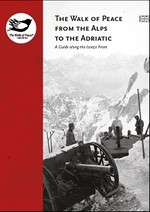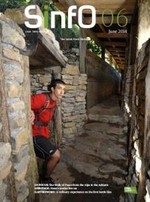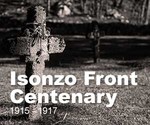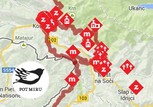I. Introduction: Slovenes in World War I
One of the most outstanding Slovenian writers Ivan Cankar named in 1917 the period he had been living in as the years of horror, that brought about moral depravity, many deaths, unspeakable suffering, but perhaps also hope and redemption. He might had anticipated that the processes and events triggered by the war would put the old world to an end and that the war's end would reinforce the need to rethink the values that would determine the future of the world.
The first World War, a significant turning point in behaviour, sentiment, an enormous cultural and not merely military event, the inducer of changes of the political map of Europe, national relations, horizons of science and technology, and of individual and collective way of comprehension of the world and events, is for the Slovenes and the history of Slovene ethnic territory undoubtedly a turning point. The Slovenes took part in different stages of the world encounter; they were soldiers, captives, deserters, prisoners of war, rebels, internees, refugees, the occupied and occupying force and above all, one of the most sanguinary battlefields of Europe – the Soča (It.: Isonzo), had taken place on Slovene territory.
Military engagement, numerically far smaller than that of the great European nations, but all the more devastating for the Slovenian national community as a whole, was outstanding in terms of military experience. The Slovenes and other inhabitants of Slovenian provinces (mostly) served in the Austro-Hungarian army; the Venetian Slovenes, citizens of the Kingdom of Italy, were mobilised into the Italian army, which also brought them to the Isonzo battlefield. Slovenian soldiers also joined volunteer troops for many reasons; Austro-Hungarian citizens of Slovenian, Croatian and Serbian nationalities first joined the Serbian army during the Balkan Wars to help Serbian soldiers achieve their military triumph and later, during World War I, to prevail in the struggle for the creation of a new Yugoslav state. In order to undermine Austria-Hungary both militarily and as a state, volunteer military units were raised on the Italian-Austrian front and for the same reason Slovenian (Yugoslav) volunteer troops were also organised in North America. Slovenian soldiers fought on the Eastern (Russian), Balkan and Italian front, they had been also part of Austro-Hungarian contingent in the German army, which brought them also on other battlefields.
At the beginning of World War I, 3,350,000 Austro-Hungarian soldiers were called to active service, two million of which were sent to the battlefields and some estimates indicate that at the beginning the war 30,000 Slovenes were part of the contingent. During the whole period of the war, some 160.000 Slovenian soldiers combated on the Austro-Hungarian theatres of war. As indicated in Austrian official reports Slovenian soldiers had, despite their pro-Yugoslav tendencies, adhered to the Emperor’s call and “[…] never lacked the devotion to make the greatest sacrifices to the last. Slovenian young men are found in every battlefield shedding blood for their beloved country.” Out of 1,2 million fallen Austro-Hungarian soldiers, between 36.000 and 40.000 were fallen Slovenian soldiers, 11,467 Slovenes were war invalids. One fifth of Slovenian families faced long-term consequences of the war; 31.039 war widows had to maintain 49.182 family members incapable of earning a livelihood.
On 23 May 1915 the Italian government declared war on Austria-Hungary, after signing the so-called London Pact on 26 April 1915, which promised it Austro-Hungarian territories: South Tyrol, Trentino, Trieste, Gorizia and Gradisca, the Tarvisio basin, part of (Slovenian) Carniola, Istria to Kvarner, the Croatian islands of Cres and Lošinj with neighbouring islands, northern Dalmatia with its islands, the islands of Sasena and Valona, the Dodecanese archipelago near the coast of Asia Minor and an appropriate share of potential territorial gains in Asia Minor and Africa. On 4 May 1915 Italy withdrew from the Triple Alliance and started feverish preparations for the war.
The South Western or Italian-Austrian front was 600 km long, stretching from the Stelvio Pass on the Swiss-Italian-Austrian border, through Tyrol, Carnia, the Soča basin, and down to the Adriatic Sea; 90 kilometres southern branch of the front, the Isonzo front , cut the Slovenian ethnic territory. The Austrian defence line started at Mount Rombon (2208 m), whence it descended through the mountains along the left bank of the Soča river, traversed the Banjšice Plateau and continued along the foot of the Kras Plateau to the Adriatic Sea at the mouth of the river Timavo (Slo. Timav). The Isonzo Front was the stage of 12 offensives, of which eleven were unleashed by the Italian army and the last one, the breaktrouhg by Bovec and Tolmin (24 October – 27 October 1917), the so –called battle of Caporetto (Kobarid) was carried out by joined Austrian and German forces, which after which the front “withdrew” from the Slovenian territory. The battles on the Isonzo took around 1.5 million casualties, 187.000 to 300.000 of who were fallen soldiers; according to some estimates, the Isonzo battlefields took the lives of 2.000 to 3.000 Slovenian soldiers. The rest of the Slovenian territory turned to the hinterland area of the front, with many military hospitals, military personnel and militarised everyday life of the civilian population.
The beginning of hostilities on the Isonzo Front unleashed a wide-spread migration movement of the civilian population in retreat from the advancing Italian army to the so-called redeemed provinces (terre redente) and the occupation of ethnic territories that did not belong to Italy but were nevertheless regarded as its crucial strategic and security asset. The Austrian government evacuated the Slovenian population (approximately 80.000) from the left flank of the front to inner Slovenian lands, as well as to refugee camps in Lower Austria, while 10.000 – 12.000 Slovenes were transported to the Kingdom of Italy.
The war in the Isonzo area left in its trail indescribable devastation, a sheer ecological and economic disaster.
On 3 November 1918, the Italian army returned to the Slovenian (former Austro-Hungarian) territory and seized it in compliance with the stipulations of the London Pact, pushing the border further eastwards. In the summer of 1919 the military administration gave way to the civil one. And finally, when the Treaty of Rapallo concerning the border between the Kingdom of Italy and the Kingdom of Serbs, Croats and Slovenes was signed on 12 November 1920, these territories were ultimately annexed to the Kingdom of Italy.
II: The memory of war
In the past ninety-five years, Slovenian remembrance of the First World War oscillated between triumph and oblivion, where oblivion accompanied the Slovenian historical remembrance of the Austro-Hungarian war experience also at the time when the First World War was part of the so-called state-building memory during the Kingdom of Yugoslavia after the First World War. In fact, the disintegration of the Habsburg Empire and the formation of a nation state of the Kingdom of Serbs, Croats and Slovenes, caused the oscillation of the Slovenian memory of World War I between forgetting and triumph, between nearly denying the war experience shared by the majority of Slovenian men in the defeated and disintegrated Austro-Hungarian Army and the triumphant rhetoric of the Serbian – and still more emphasised Yugoslav – volunteer war experience, characterised by limited Slovenian participation and minor importance in Slovenian military history. After the Second World War the First World War had to withdraw from public memory and historiographical treaties to the margins of remembrance; the Second World War practically marginalized her older sister and also changed the perspective of the understanding and interpreting the Great War.
There is no doubt that the tumultuous time, which led to the outbreak of the war, decisively distorted the Slovenian view of World War I and Austria-Hungary; the perception of Austria as the prison of nations, although it never appeared in historiography under this name, was the product of the acutely insightful memorial literature on the creation of the state in the First Yugoslavia.
With the downfall of the Hapsburg empire and the creation of the Kingdom of Serbs, Croats and Slovenes, with a one-month episode of the independent State of Slovenes, Croats and Serbs, but also due to the loss of one third of national territories in the following two post- war years, the Slovenian provinces fundamentally changed their historical perspective. The Austrian idealistic concept of history was replaced with the ethnocentric Yugoslav concept of history and remembering. Historical remembrance of the past, including World War I presented a trying experience in the first Yugoslavia, being the War a unifying and separating element at the same time. Thus it caused an extremely discriminating relationship between the victors/liberators/unifiers (i.e. Serbs, Montenegrins, volunteers) and the vanquished/liberated/united (Slovenes, Croats and Serbs from the former Habsburg monarchy). In this situation it was impossible to celebrate both victory and defeat at the same time. This had a decisive impact on the position of the Slovenian war experience in the state-building memory of World War I fostered in the Kingdom of Serbs, Croats and Slovenes. The later was based on the Yugoslav identity, achieved during the Great War and emphasised the past of volunteers and Southern Slavs unification.
The period between the two world wars was significantly prolific in terms of publications on the First World War, with a vast corpus of memoires of the war years on the eastern front, war captivity, military mutinies and above all, the volunteer’s movement, which involved not more than 2000 Slovenes. The later adapted to the central Yugoslav political current in creating the common Yugoslav culture and uniform memory of the historical events.
The only public bearers of the interwar Slovenian memory were Slovenian war veterans, whose clear objective was to garner public support and acknowledgement of the efforts made by the Slovenian soldiers during World War I. They tried to persuade Serbian and Montenegrin veterans, whose war had been crowned by victory, that the Slovenian experience of war should not be neglected. But till the end of the first Yugoslavia there where at least two parallel narratives on World War I: the Yugoslav one and the former Austro-Hungarian one, which prevented the formation of a uniform Yugoslav historical discourse of World War I.
The principal activity of Slovenian war veterans was concentrated around the economic issues of the veterans, war invalids and war widows, as well as dedicated to the memory of their fallen comrades, which resulted in more than 160 memorials and memorial plaques all over Slovenian territory, but they were unable to ensure a central Slovenian memorial or a monument to the Unknown soldier, promoted and somehow adopted by the Slovenian political authorities.
One of the neglected themes of the Slovenian war experience was also the memory of the Isonzo front, which did not witness a wider public interest, and even less the state/Yugoslav acknowledgement, as it was not a Yugoslavia making front. The post-war situation in the Isonzo region, occupied and later annexed to Italy laid a heavy burden on the remembrance of the war on Isonzo; due to the Italian oppression no public memory was permitted, on the other hand the Italian government raised up monumental ossuaries along the whole former front, thus three also along the Isonzo river in Kobarid (now in Slovenia), Oslavje (near Gorizia/Gorica with a very dense Slovenian population) and Redipuglia. The remembrance of the war on the Isonzo front and that of the fallen Slovenian soldiers was pushed in the domestic and intimate sphere.
The end of the Second World War and the creation of socialist Yugoslavia altered the Slovenian as well as Yugoslav narration of the First World War events. This period was marked by the withdrawal from public memory, as well as from historical debates and publishing, no matter what theme, subject or area. The social revolution brought new perspective; the social-revolutionary elements were introduced in the historical narrative practices. The First World War, together with the Isonzo front, became a second class historical topic, because it did not fit well in neither in the concept of supranational martyrdom of the partisan liberation movement during World War II, nor in the concept of brotherhood and unity of the post Second World War socialist Yugoslavia.
Only after 1980`s an awaken public and historiographical interest in World war I caused an increasing interest, producing many war memoirs, exhibitions, private museums and a systematic and modern historical research. The central theme of the historical remembrance became the Isonzo front. The turning points in Slovenian historiography on World War I were marked by the establishing the first museum of the First World War in Kobarid in 1990, the first PhD in the history of the First World War in 1998 and the first interdisciplinary Slovenian conference The Great War and the Slovenes was in 2004. Slovenian history of the First World War was then set in the European context, with the use of terminology deemed to determine best the multidimensionality of wartime and war experience, which were transposed into a cultural-historical perspective.
The decades-long Slovenian oblivion of the First World War came to an end quite simultaneously with the democratic changes and the Slovenian state independence, but thus could be a mere coincidence.
III. Commemoration 2014 – 2018
By establishing the National Committee for commemorating the 100th Anniversaries of World War I (2014 – 2018) in summer 2012, the Republic of Slovenia has become actively involved in the Pan-European commemoration of the Centenary of the World War I. The National Committee contributes to deepen the collective memory of the Slovenes about a profound influence that World War I had on life of every inhabitant and the entire community, not only in the sense of political changes, but above all and primarily in the context of diverse experiences brought by the war.
The National Committee is presided by the Minister of Defence and composed of representatives of the Ministry of Defence, Ministry of Foreign Affairs, Ministry of Education, Science and Sport, Office of the President of the Republic of Slovenia, Government Communication Office and Public Agency of the Republic of Slovenia for the Promotion of Entrepreneurship, Innovation, Development, Investment and Tourism, as well as scientific, museum and archive institutions.
In the period of commemorating the 100th anniversaries of World War I, the National Committee as the main (national) committee will play the coordination role and will at the same time closely cooperate with the institutions that have been involved with systematic study of the World War I history for the past two decades, in particular with the Isonzo Front, its movable and immovable heritage, as well as promotion of high-quality historical and cultural tourism. These institutions include primarily: Kobarid Museum (Kobarid), Walk of Peace in the Soča Region Foundation (Kobarid), Tolmin Museum (Tolmin), Goriška Museum (Nova Gorica), National Museum of Contemporary History (Ljubljana) and Scientific Research Centre of the Slovenian Academy of Sciences and Arts (Ljubljana). It should also be mentioned that several other Slovenian national and regional institutions (museums, archives) take part in commemorating activities of the 100th anniversaries of World War I.
The National Committee prepares and updates the calendar of events on World War I which will be held in the period 2014 – 2018 on the territory of Slovenia or organized by the embassies of the Republic of Slovenia abroad. The calendar can be accessed at the website domain http://www.100letprve.si (http://www.100letprve.si/en/).
On 9 September 2014 the National Committee organized the first state commemoration under patronage of President of the Republic of Slovenia at the Ossuary of the victims of World War I at the Cemetery Žale in Ljubljana. Each year in the period 2014 – 2018, the National Committee will (co)organize one main national event. On 21 March 2015 the »Walk of Peace from the Alps to the Adriatic« will be opened on the joined Slovenian – Italian square Trg Evrope (Europe Square)/Transalpina between Nova Gorica and Gorizia (Gorica), under honorary patronage of President of the Republic of Slovenia and President of the Italian Republic. In 2016 the Ceremony at the Russian chapel beneath Vršič pass will commemorate the 100th anniversary of its construction and the victims of the avalanche, which claimed several hundreds of victims – Russian prisoners of war and their Austrian guards. In July 2017 maestro Riccardo Mutti will conduct a concert of Ravenna Philharmonic and several military orchestras, commemorating the Centenary of the 12th battle of Isonzo. The year 2018 will be characterised by signing and promoting the European Covenant on Peace.
The first year of the First World War Centenary was marked by a number of exhibitions and events. “We never imagined such a war” was the central Slovenian exhibition at the National Museum of Contemporary History in Ljubljana. The exhibition tries to capture the weight of time between 1914 and 1918 through 13 personal stories, written by the life during the Great War (http://www.muzej-nz.si/1vojna/1vojna.html). The exhibition represented the basis for two regional exhibition at the Museum of recent history Celje and Museum of Kobarid, with the same title, but with the additione of regional stories and collections. The majority of the Slovenian regional museums devoted their 2014 exhibitions to the Centenary of the First World War (National Liberation Museum Maribor, Goriški muzej Nova Gorica, Dolenjski muzej Novo mesto, National Museum of Slovenia in Ljubljana, Regional Museum Maribor, Intermunicipal Museum of Kamnik, Ptuj Regional Museum ). The National and University Library in Ljubljana exhibited the heritage of the First World War located in all librariy` divisions. The Slovenian regional archives also joined their forces for a wandering archival exposition of documents on war. The National Committee`s calendar thus recorded more than 30 events, a unique web page of the Slovenian public broadcaster (http://www.rtvslo.si/1sv) and a wide public interest. Gaining public attention, bringing to forth the notion of the fact, that the First World War was one of the crucial turning points in Slovenian contemporary history, was one of the main objectives of the National Committee and remains in the focus of members` activities also in the years to come.
Petra Svoljšak, Milko Kos Historical Institute, Slovenian Academy of Sciences and Arts
Bibliography
SCHINDLER, John R.
Isonzo : the forgotten sacrifice of the Great War / John R. Schindler. - Westport, Connecticut ; London : Praeger, cop. 2001
KOREN, Tadej
The walk of peace : a guide along the Isonzo Front in the Upper Soča region / [text by Tadej Koren ; translated by Branka Klemenc ; maps of the section Geodetski inštitut Slovenije ; map of the Walk of peace Ana Hawlina ; course of the Walk of peace on photos Arttech]. - Kobarid : The Walks of Peace in the Soča Region Foundation, 2008
SVOLJŠAK, Petra,
Soča, sveta reka : italijanska zasedba slovenskega ozemlja (1915-1917). - Ljubljana : Nova revija, 2003.
SVOLJŠAK, Petra,
The front on Soča / Petra Svoljšak ; [photographs Željko Cimprič ... et al.]. - Ljubljana : Cankarjeva založba, 2002.
SVOLJŠAK, Petra,
Slovenian historiography and collective memory of the World War I in the First Yugoslavia (1918-1941) . In: Twentieth century wars in European memory / Józef Niżnik (ed.). - Frankfurt am Main [etc.] : P. Lang, 2013.
SVOLJŠAK, Petra
The social history of the Soča/Isonzo region in the First World War . In: Sozialgeschichte und soziale Bewegungen in Slowenien / Herausgegeben von Sabine Rutar und Rolf Wörsdorfer. Essen : Klartext, 2009. pp. 89-109.
KLAVORA, Vasja
Blaukreuz : die Isonzofront : Flitsch/Bovec : 1915-1917 / Vasja Klavora ; [aus dem Slowenischen übersetzt von Hanzi Filipič]. - 3., unveränderte Aufl. - Klagenfurt ; Ljubljana ; Wien : Hermagoras = Mohorjeva, 2003.
The FIRST World War Outdoor Museums : the Isonzo Front, 1915-1917 / [translators Miha Obit, Branka Klemenc ; editor Tadej Koren ; photos by Tamino Petelinšek ... [et al.]]. - Kobarid : Ustanova Fundacija Poti miru v Posočju = The Walk of Peace in the Soča Region Foundation, 2013






